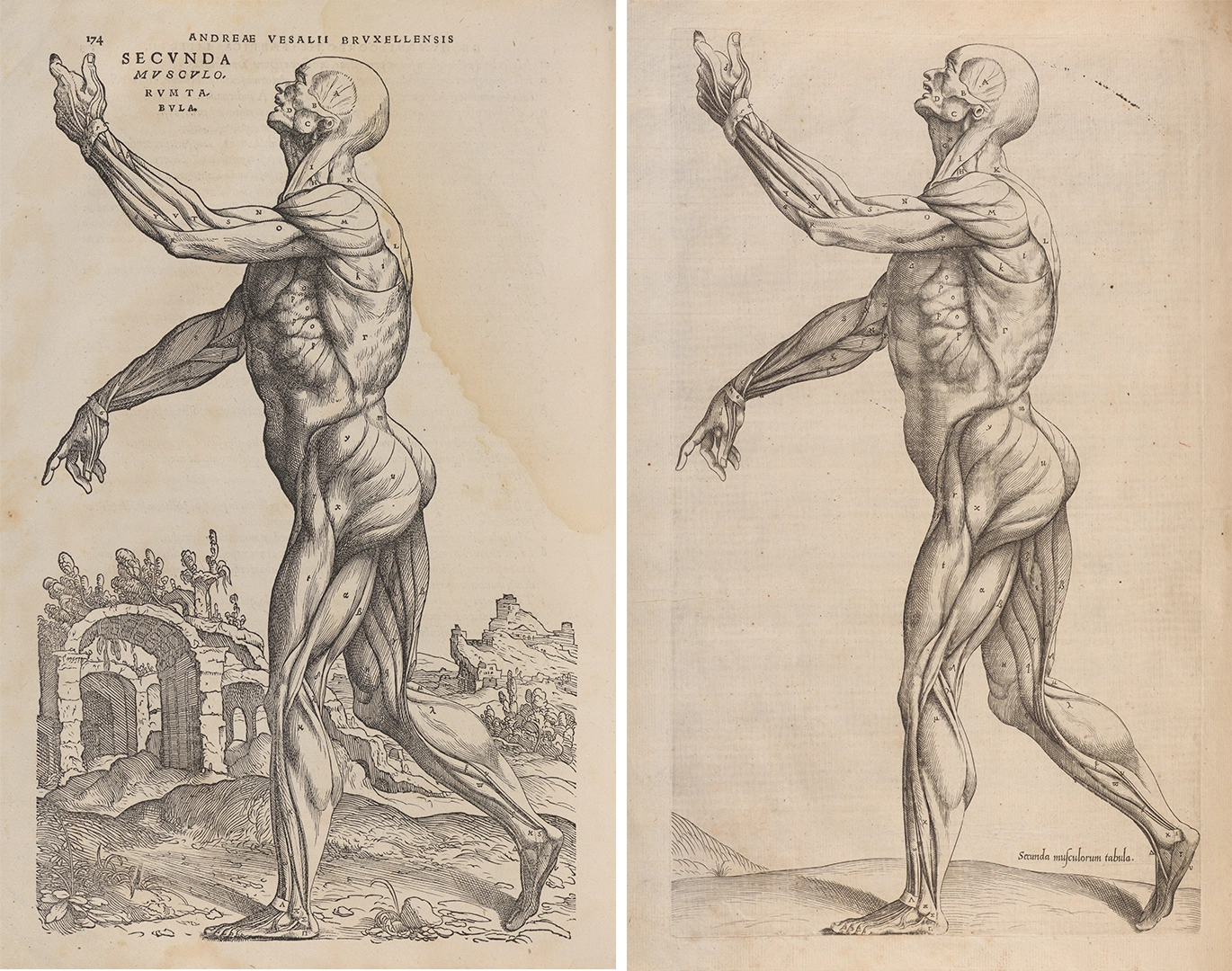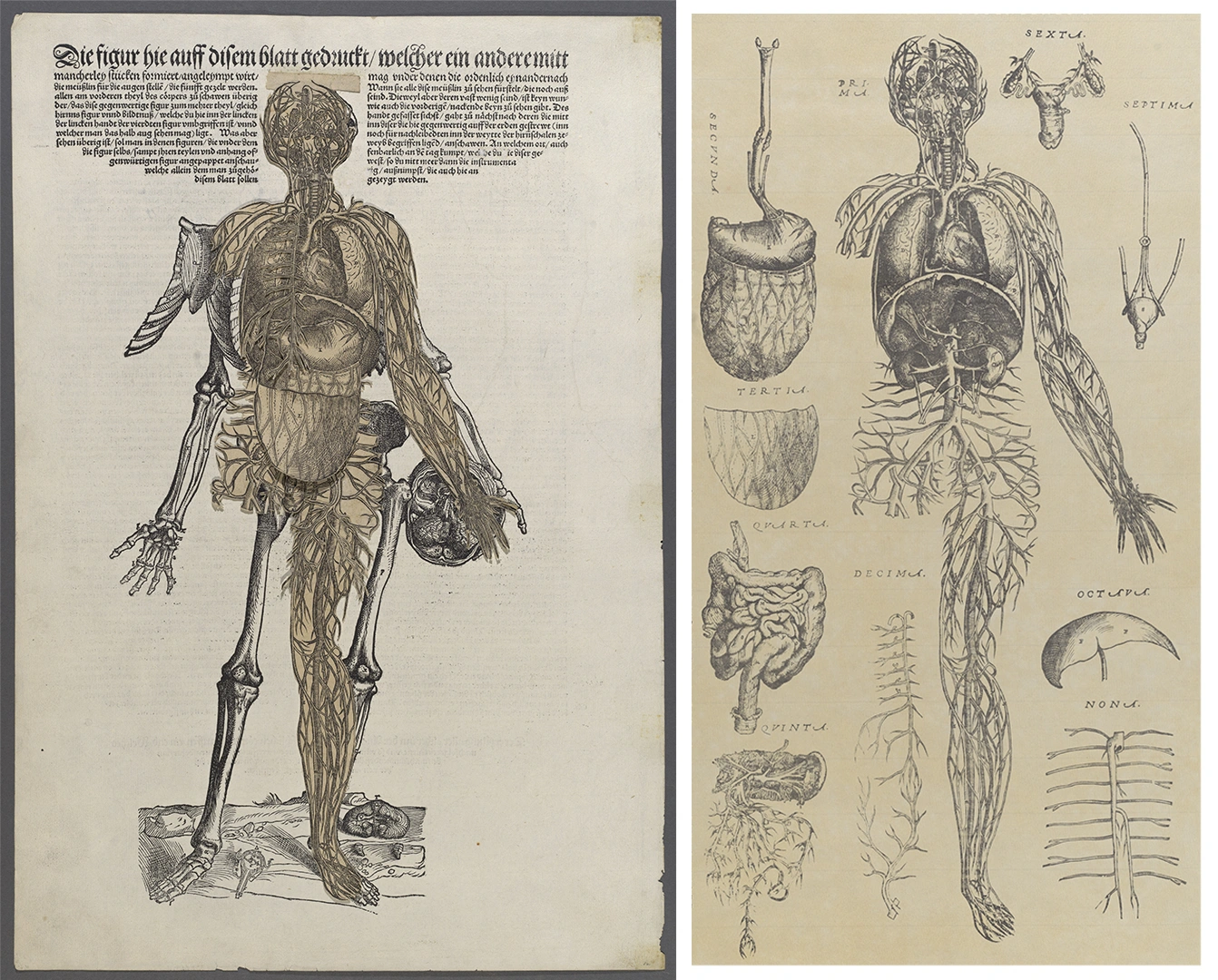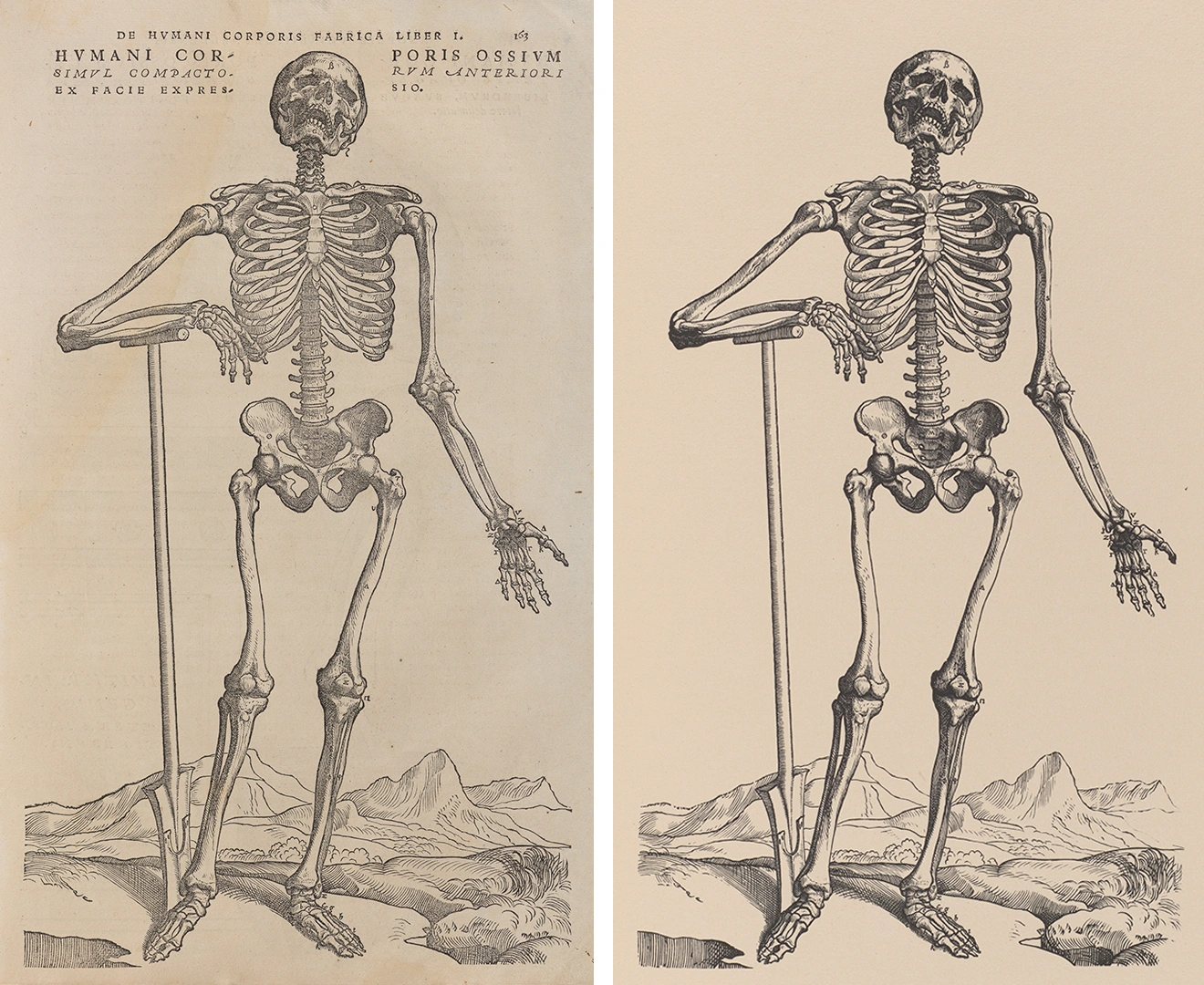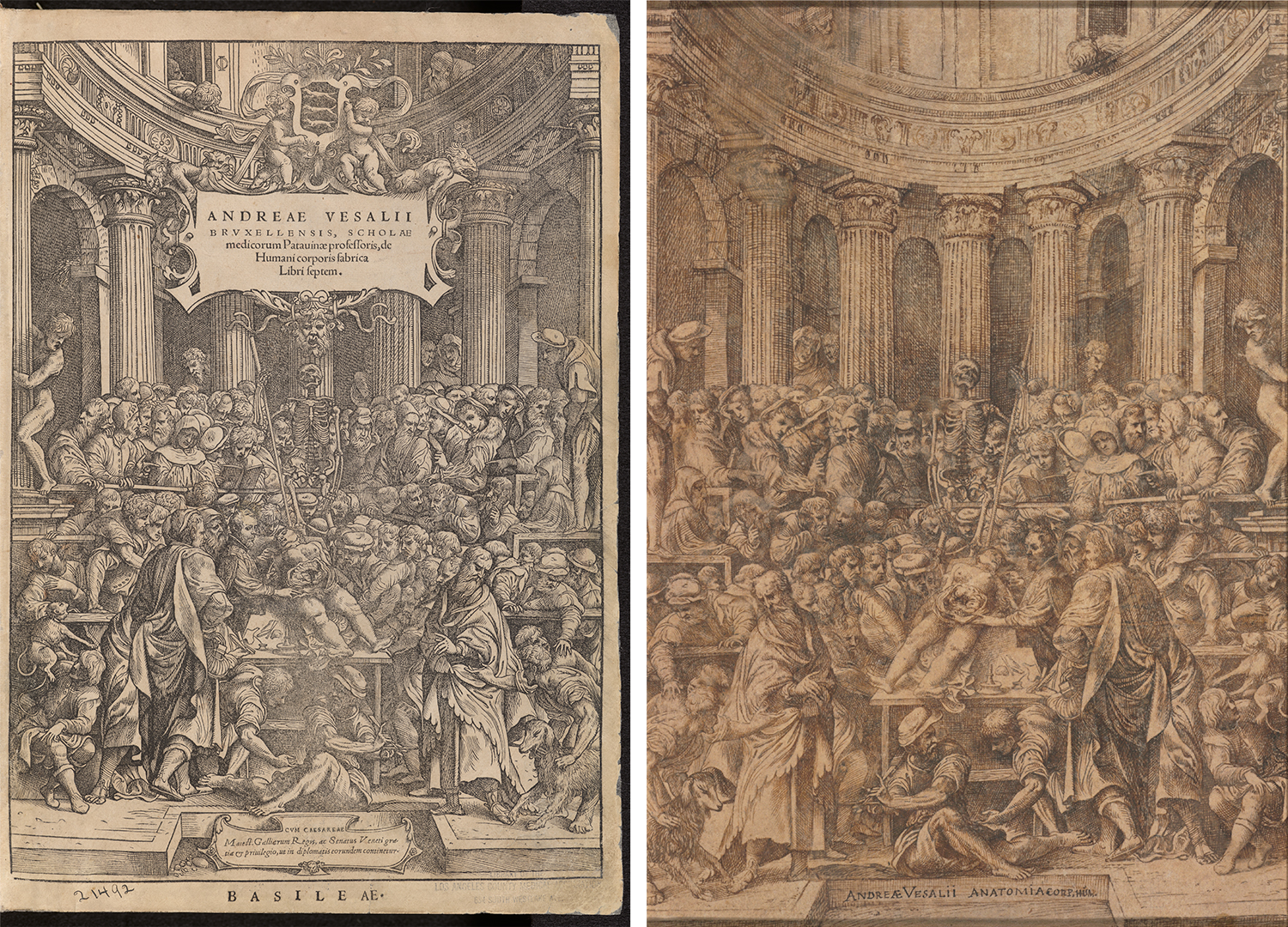
Left: Andreas Vesalius, De humani corporis fabrica, 1543, title page. The title page of the Fabrica features an elaborate illustration of Vesalius performing a public dissection in an anatomy theater. This title page appears in the Fabrica that once belonged to the Los Angeles County Medical Association Library. Right: Jan Stephan van Calcar, Title page for Andreas Vesalius’ “Fabrica,” no date, pen and brown ink, 13 5/8 × 9 3/4 in. (34.6 × 24.8 cm). Edward W. and Julia B. Bodman Collection. The original drawing for the title page by Vesalius’ collaborator Jan Stephan van Calcar (ca. 1499–ca. 1546) is one of the most remarkable items in The Huntington’s medical collections. | The Huntington Library, Art Museum, and Botanical Gardens.
When I’m asked what I most love about being a library curator, I often say that it’s like hosting a grand dinner party—the magic happens in the conversations among guests. Individual books and manuscripts are certainly interesting on their own, but they often yield their most intriguing secrets and stories through their connections with other items. Curating these dialogues is a great privilege, and I recently had the opportunity to arrange a homecoming of sorts by reuniting a special book with its former collection.
Thanks to generous supporters, The Huntington has acquired a 1543 first edition of De humani corporis fabrica (On the fabric of the human body), by the Flemish physician and anatomist Andreas Vesalius (1514–1564). In his momentous book, Vesalius revolutionized the field of anatomy by providing detailed and accurate descriptions of the body based on the direct observation and dissection of humans. The volume’s large, folio-sized woodcut illustrations conveyed the beauty and complexity of the human body with unprecedented clarity. Sir William Osler (1849–1919), one of the founders of the Johns Hopkins School of Medicine, succinctly described Vesalius’ Fabrica as “the greatest medical book ever written.”
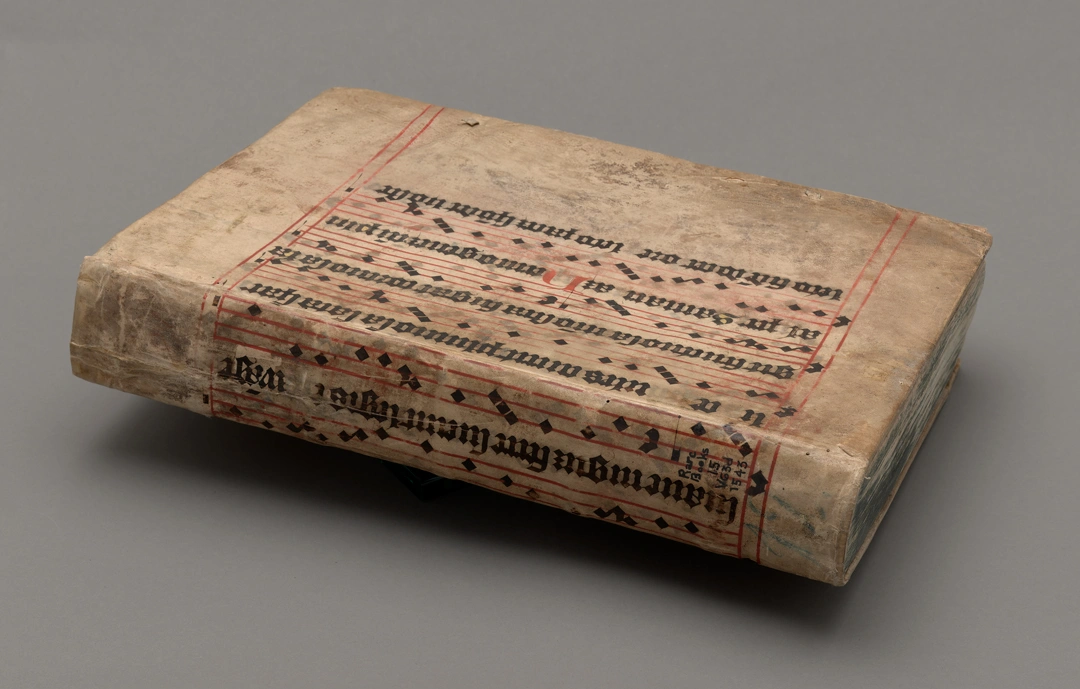
Andreas Vesalius, De humani corporis fabrica, 1543. Concealed in a binding made from a medieval antiphonal leaf is one of the most treasured books in the history of medicine. (Antiphonal music is meant to be sung or played by two groups in turn.) This copy of the Fabrica, acquired by The Huntington, once belonged to the Los Angeles County Medical Association Library. | The Huntington Library, Art Museum, and Botanical Gardens.
The Fabrica recently acquired by The Huntington once belonged to the Los Angeles County Medical Association Library and was the first rare book purchased for its collection. In 1937, Dr. Hyman Miller, a local physician, arranged for the association to acquire the book with funds raised by the Los Angeles Lions Club. Notable Viennese antiquarian book dealer Gilhofer and Ranschburg sold the Fabrica for approximately 762 Swiss francs (roughly $175 at the time). In its 1937 catalog, the dealer described the volume as coming from “an old Austrian out-of-the-way monastery, where [it] had remained for centuries.”
For decades, this book was the pinnacle of the Los Angeles County Medical Association’s library collection, embodying the association’s commitment to medical history and education. Then, in the early 1990s, they generously presented their extraordinary pre-1800 special collections to The Huntington. However, when these collections were transferred over, several of the books that duplicated Huntington items were auctioned, including their copy of the Fabrica. This wasn’t an uncommon practice at the time and was done to avoid redundancy and manage collections efficiently.
Left: Andreas Vesalius, De humani corporis fabrica, 1543, page 174. Arguably the most famous images from the Fabrica are the so-called “muscle men,” showing full-body depictions of human musculature. The image on the left shows a figure from what was once the Los Angeles County Medical Association’s Fabrica. Right: Thomas Geminus, Compendiosa Totius Anatomiae Delineatio, 1545, plate 7. The illustration on the right is from a text by the Englishman Thomas Geminus that used Vesalius’ images without authorization. While pirated, Geminus’ images are noteworthy because they were printed with copper engravings instead of woodblocks. | The Huntington Library, Art Museum, and Botanical Gardens.
The Huntington does indeed have another copy of the 1543 Fabrica, but it was unfortunately damaged before its arrival at the institution many decades ago. In short, a well-meaning bibliophile applied an oil-based leather dressing to preserve the book’s binding. Unfortunately, the oil seeped through the binding over the years and not only stained the book’s pages but cross-linked with oxygen in the air, making the paper liable to brittleness and further damage. The book was disbound, and The Huntington’s conservators have done amazing work to preserve it, but while it has been stabilized, the damage remains.
So, when I received an email from a bookseller who had acquired a 1543 Fabrica containing a stamp from the Los Angeles County Medical Association, I was elated and crestfallen at the same time. As much as I craved to have this book for The Huntington’s collections, I knew that first editions of the Fabrica are dear. Originally daunted by the seeming impossibility of acquiring this book, I was soon awed by the enthusiasm of several local book lovers and doctors who donated magnanimously, making it possible for The Huntington to reunite this invaluable volume with its rightful home.
Left: Andreas Vesalius, Von des menschen Cörpers Anatomey …, 1543, page 16. A fully assembled “flap anatomy” from the 1543 German edition of Vesalius’ Epitome, a much-abbreviated version of his Fabrica that was often used by students. By lifting the paper flaps, readers could peer into the human body one layer at a time. Right: Andreas Vesalius, Von des menschen Cörpers Anatomey …, 1543, facsimile from the Latin edition. This is a page from which the flaps could be cut and then assembled. | The Huntington Library, Art Museum, and Botanical Gardens.
In addition to being reunited with other books that had been in the Los Angeles County Medical Association’s collections, the Fabrica joins numerous Vesalian treasures already in The Huntington’s holdings. These include two copies of the 1555 second edition of the Fabrica, the 1725 first complete compilation of Vesalius’ anatomical texts, and what is likely the original pen drawing for the Fabrica’s title page by Jan Stephan van Calcar (ca. 1499–ca.1546), Vesalius’ collaborator and a former student of the painter Titian. The Huntington is also fortunate to have a rare 1543 German copy of the Epitome, a much-abbreviated version of the Fabrica that was often used by students. The Huntington’s copy is noteworthy because it contains fully assembled paper “flap anatomies” that allow a reader to peer into the human body one layer at a time.
Left: Skeleton figure from Andreas Vesalius’ De humani corporis fabrica, 1543. Right: The same figure from Andreas Vesalius’ Icones anatomicae, 1934. The original woodblocks for printing the Fabrica famously survived and were used one last time to reprint the illustrations in Icones anatomicae, a collaboration of the New York Academy of Medicine with Bremer Press and the University of Munich. The image on the left shows a skeleton figure from the Los Angeles County Medical Association’s 1543 Fabrica, printed when the woodblocks were new. The illustration on the right shows the same figure in the 1934 Icones anatomicae. The woodblocks had worn down over time, leading to some loss of detail in the latter image. Tragically, the woodblocks were destroyed during the bombing of Munich in World War II. | The Huntington Library, Art Museum, and Botanical Gardens. Image on the right displayed with permission from the New York Academy of Medicine.
Reacquiring the Fabrica not only restores a significant piece of medical history to The Huntington but also honors the legacy of the Los Angeles County Medical Association Library. This book, with its storied past and enduring significance, is once again celebrated as the pinnacle of its collection. Bringing it into our holdings is like welcoming a distinguished guest back to the party after a long vacation—and only time will tell what further stories this reunion will reveal.
The acquisition of the Los Angeles County Medical Association’s Fabrica was made possible through the generosity of The Francis Bacon Foundation, The Dorothy L. Johnston Foundation, Michael Mackness and Eric Sigg, The Southern California Society for the History of Medicine, Drs. Martha and Faustino Bernadett, John Wm. Jr. and Norva Lee Devereux, Dr. and Mrs. J. Mario Molina, the Los Angeles County Medical Association, Dr. Yushu Chou, Dr. George Fouras, Dr. Po-Yin Samuel Huang, Dr. Nuriel Moghavem, Dr. Linda Mirdamadi, Dr. C. Freeman, Dr. Heather Silverman, Dr. Nancy Ellerbroek, Dr. Michael Ong, and Dr. Marc Mendes.
Joel A. Klein is the Molina Curator for the History of Medicine and Allied Sciences at The Huntington.
Please note that the Library items in this story are not on view.


